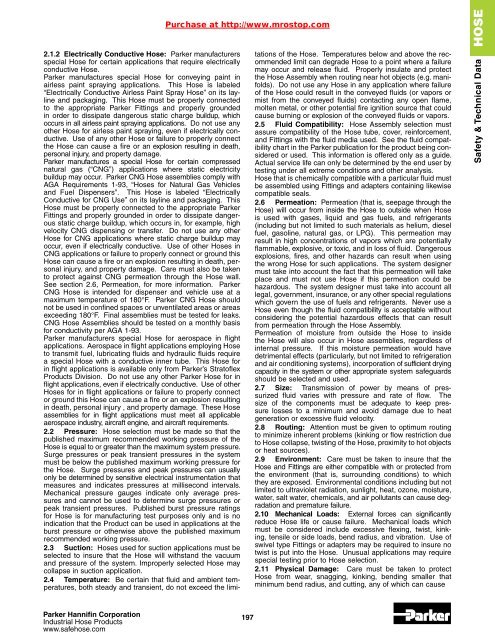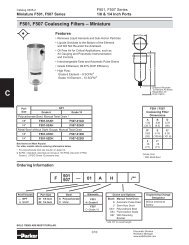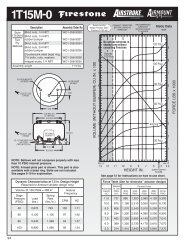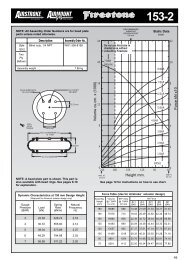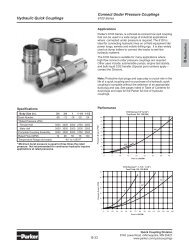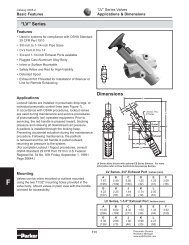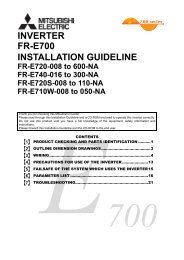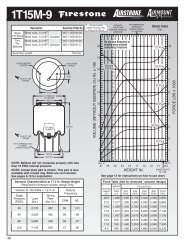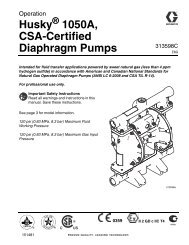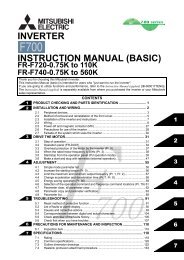Parker Industrial Hose Catalog 4800 - MRO Stop
Parker Industrial Hose Catalog 4800 - MRO Stop
Parker Industrial Hose Catalog 4800 - MRO Stop
You also want an ePaper? Increase the reach of your titles
YUMPU automatically turns print PDFs into web optimized ePapers that Google loves.
2.1.2 Electrically Conductive <strong>Hose</strong>: <strong>Parker</strong> manufacturersspecial <strong>Hose</strong> for certain applications that require electricallyconductive <strong>Hose</strong>.<strong>Parker</strong> manufactures special <strong>Hose</strong> for conveying paint inairless paint spraying applications. This <strong>Hose</strong> is labeled“Electrically Conductive Airless Paint Spray <strong>Hose</strong>” on its laylineand packaging. This <strong>Hose</strong> must be properly connectedto the appropriate <strong>Parker</strong> Fittings and properly groundedin order to dissipate dangerous static charge buildup, whichoccurs in all airless paint spraying applications. Do not use anyother <strong>Hose</strong> for airless paint spraying, even if electrically conductive.Use of any other <strong>Hose</strong> or failure to properly connectthe <strong>Hose</strong> can cause a fire or an explosion resulting in death,personal injury, and property damage.<strong>Parker</strong> manufactures a special <strong>Hose</strong> for certain compressednatural gas (“CNG”) applications where static electricitybuildup may occur. <strong>Parker</strong> CNG <strong>Hose</strong> assemblies comply withAGA Requirements 1-93, “<strong>Hose</strong>s for Natural Gas Vehiclesand Fuel Dispensers”. This <strong>Hose</strong> is labeled “ElectricallyConductive for CNG Use” on its layline and packaging. This<strong>Hose</strong> must be properly connected to the appropriate <strong>Parker</strong>Fittings and properly grounded in order to dissipate dangerousstatic charge buildup, which occurs in, for example, highvelocity CNG dispensing or transfer. Do not use any other<strong>Hose</strong> for CNG applications where static charge buildup mayoccur, even if electrically conductive. Use of other <strong>Hose</strong>s inCNG applications or failure to properly connect or ground this<strong>Hose</strong> can cause a fire or an explosion resulting in death, personalinjury, and property damage. Care must also be takento protect against CNG permeation through the <strong>Hose</strong> wall.See section 2.6, Permeation, for more information. <strong>Parker</strong>CNG <strong>Hose</strong> is intended for dispenser and vehicle use at amaximum temperature of 180°F. <strong>Parker</strong> CNG <strong>Hose</strong> shouldnot be used in confined spaces or unventilated areas or areasexceeding 180°F. Final assemblies must be tested for leaks.CNG <strong>Hose</strong> Assemblies should be tested on a monthly basisfor conductivity per AGA 1-93.<strong>Parker</strong> manufacturers special <strong>Hose</strong> for aerospace in flightapplications. Aerospace in flight applications employing <strong>Hose</strong>to transmit fuel, lubricating fluids and hydraulic fluids requirea special <strong>Hose</strong> with a conductive inner tube. This <strong>Hose</strong> forin flight applications is available only from <strong>Parker</strong>’s StratoflexProducts Division. Do not use any other <strong>Parker</strong> <strong>Hose</strong> for inflight applications, even if electrically conductive. Use of other<strong>Hose</strong>s for in flight applications or failure to properly connector ground this <strong>Hose</strong> can cause a fire or an explosion resultingin death, personal injury , and property damage. These <strong>Hose</strong>assemblies for in flight applications must meet all applicableaerospace industry, aircraft engine, and aircraft requirements.2.2 Pressure: <strong>Hose</strong> selection must be made so that thepublished maximum recommended working pressure of the<strong>Hose</strong> is equal to or greater than the maximum system pressure.Surge pressures or peak transient pressures in the systemmust be below the published maximum working pressure forthe <strong>Hose</strong>. Surge pressures and peak pressures can usuallyonly be determined by sensitive electrical instrumentation thatmeasures and indicates pressures at millisecond intervals.Mechanical pressure gauges indicate only average pressuresand cannot be used to determine surge pressures orpeak transient pressures. Published burst pressure ratingsfor <strong>Hose</strong> is for manufacturing test purposes only and is noindication that the Product can be used in applications at theburst pressure or otherwise above the published maximumrecommended working pressure.2.3 Suction: <strong>Hose</strong>s used for suction applications must beselected to insure that the <strong>Hose</strong> will withstand the vacuumand pressure of the system. Improperly selected <strong>Hose</strong> maycollapse in suction application.2.4 Temperature: Be certain that fluid and ambient temperatures,both steady and transient, do not exceed the limi-Purchase at http://www.mrostop.comtations of the <strong>Hose</strong>. Temperatures below and above the recommendedlimit can degrade <strong>Hose</strong> to a point where a failuremay occur and release fluid. Properly insulate and protectthe <strong>Hose</strong> Assembly when routing near hot objects (e.g. manifolds).Do not use any <strong>Hose</strong> in any application where failureof the <strong>Hose</strong> could result in the conveyed fluids (or vapors ormist from the conveyed fluids) contacting any open flame,molten metal, or other potential fire ignition source that couldcause burning or explosion of the conveyed fluids or vapors.2.5 Fluid Compatibility: <strong>Hose</strong> Assembly selection mustassure compatibility of the <strong>Hose</strong> tube, cover, reinforcement,and Fittings with the fluid media used. See the fluid compatibilitychart in the <strong>Parker</strong> publication for the product being consideredor used. This information is offered only as a guide.Actual service life can only be determined by the end user bytesting under all extreme conditions and other analysis.<strong>Hose</strong> that is chemically compatible with a particular fluid mustbe assembled using Fittings and adapters containing likewisecompatible seals.2.6 Permeation: Permeation (that is, seepage through the<strong>Hose</strong>) will occur from inside the <strong>Hose</strong> to outside when <strong>Hose</strong>is used with gases, liquid and gas fuels, and refrigerants(including but not limited to such materials as helium, dieselfuel, gasoline, natural gas, or LPG). This permeation mayresult in high concentrations of vapors which are potentiallyflammable, explosive, or toxic, and in loss of fluid. Dangerousexplosions, fires, and other hazards can result when usingthe wrong <strong>Hose</strong> for such applications. The system designermust take into account the fact that this permeation will takeplace and must not use <strong>Hose</strong> if this permeation could behazardous. The system designer must take into account alllegal, government, insurance, or any other special regulationswhich govern the use of fuels and refrigerants. Never use a<strong>Hose</strong> even though the fluid compatibility is acceptable withoutconsidering the potential hazardous effects that can resultfrom permeation through the <strong>Hose</strong> Assembly.Permeation of moisture from outside the <strong>Hose</strong> to insidethe <strong>Hose</strong> will also occur in <strong>Hose</strong> assemblies, regardless ofinternal pressure. If this moisture permeation would havedetrimental effects (particularly, but not limited to refrigerationand air conditioning systems), incorporation of sufficient dryingcapacity in the system or other appropriate system safeguardsshould be selected and used.2.7 Size: Transmission of power by means of pressurizedfluid varies with pressure and rate of flow. Thesize of the components must be adequate to keep pressurelosses to a minimum and avoid damage due to heatgeneration or excessive fluid velocity.2.8 Routing: Attention must be given to optimum routingto minimize inherent problems (kinking or flow restriction dueto <strong>Hose</strong> collapse, twisting of the <strong>Hose</strong>, proximity to hot objectsor heat sources).2.9 Environment: Care must be taken to insure that the<strong>Hose</strong> and Fittings are either compatible with or protected fromthe environment (that is, surrounding conditions) to whichthey are exposed. Environmental conditions including but notlimited to ultraviolet radiation, sunlight, heat, ozone, moisture,water, salt water, chemicals, and air pollutants can cause degradationand premature failure.2.10 Mechanical Loads: External forces can significantlyreduce <strong>Hose</strong> life or cause failure. Mechanical loads whichmust be considered include excessive flexing, twist, kinking,tensile or side loads, bend radius, and vibration. Use ofswivel type Fittings or adapters may be required to insure notwist is put into the <strong>Hose</strong>. Unusual applications may requirespecial testing prior to <strong>Hose</strong> selection.2.11 Physical Damage: Care must be taken to protect<strong>Hose</strong> from wear, snagging, kinking, bending smaller thatminimum bend radius, and cutting, any of which can causeHOSESafety & Technical Data<strong>Parker</strong> Hannifin Corporation<strong>Industrial</strong> <strong>Hose</strong> Productswww.safehose.com197


